java面试强基(11)
java面试强基(11)

一个风轻云淡
发布于 2023-10-15 09:24:03
发布于 2023-10-15 09:24:03
代码可运行
运行总次数:0
代码可运行

try-catch-finally 如何使用?
try块 : 用于捕获异常。其后可接零个或多个catch块,如果没有catch块,则必须跟一个finally块。catch块 : 用于处理 try 捕获到的异常。finally块 : 无论是否捕获或处理异常,finally块里的语句都会被执行。当在try块或catch块中遇到return语句时,finally语句块将在方法返回之前被执行。
注意:不要在 finally 语句块中使用 return! 当 try 语句和 finally 语句中都有 return 语句时,try 语句块中的 return 语句会被忽略。这是因为 try 语句中的 return 返回值会先被暂存在一个本地变量中,当执行到 finally 语句中的 return 之后,这个本地变量的值就变为了 finally 语句中的 return 返回值。
finally 中的代码一定会执行吗?
不一定的!在某些情况下,finally 中的代码不会被执行。
就比如说 finally 之前虚拟机被终止运行的话,finally 中的代码就不会被执行。
如何使用 try-with-resources 代替try-catch-finally?
- 适用范围(资源的定义): 任何实现
java.lang.AutoCloseable或者java.io.Closeable的对象 - 关闭资源和 finally 块的执行顺序: 在
try-with-resources语句中,任何 catch 或 finally 块在声明的资源关闭后运行
《Effective Java》中明确指出:
面对必须要关闭的资源,我们总是应该优先使用
try-with-resources而不是try-finally。随之产生的代码更简短,更清晰,产生的异常对我们也更有用。try-with-resources语句让我们更容易编写必须要关闭的资源的代码,若采用try-finally则几乎做不到这点。
Java 中类似于InputStream、OutputStream 、Scanner 、PrintWriter等的资源都需要我们调用close()方法来手动关闭,一般情况下我们都是通过try-catch-finally语句来实现这个需求,如下:
//读取文本文件的内容
Scanner scanner = null;
try {
scanner = new Scanner(new File("D://read.txt"));
while (scanner.hasNext()) {
System.out.println(scanner.nextLine());
}
} catch (FileNotFoundException e) {
e.printStackTrace();
} finally {
if (scanner != null) {
scanner.close();
}
}使用 Java 7 之后的 try-with-resources 语句改造上面的代码:
try (Scanner scanner = new Scanner(new File("test.txt"))) {
while (scanner.hasNext()) {
System.out.println(scanner.nextLine());
}
} catch (FileNotFoundException fnfe) {
fnfe.printStackTrace();
}当然多个资源需要关闭的时候,使用 try-with-resources 实现起来也非常简单,如果你还是用try-catch-finally可能会带来很多问题。
通过使用分号分隔,可以在try-with-resources块中声明多个资源。
try (BufferedInputStream bin = new BufferedInputStream(new FileInputStream(new File("test.txt")));
BufferedOutputStream bout = new BufferedOutputStream(new FileOutputStream(new File("out.txt")))) {
int b;
while ((b = bin.read()) != -1) {
bout.write(b);
}
}
catch (IOException e) {
e.printStackTrace();
}本文参与 腾讯云自媒体同步曝光计划,分享自作者个人站点/博客。
原始发表:2022-11-25,如有侵权请联系 cloudcommunity@tencent.com 删除
评论
登录后参与评论
推荐阅读
目录

